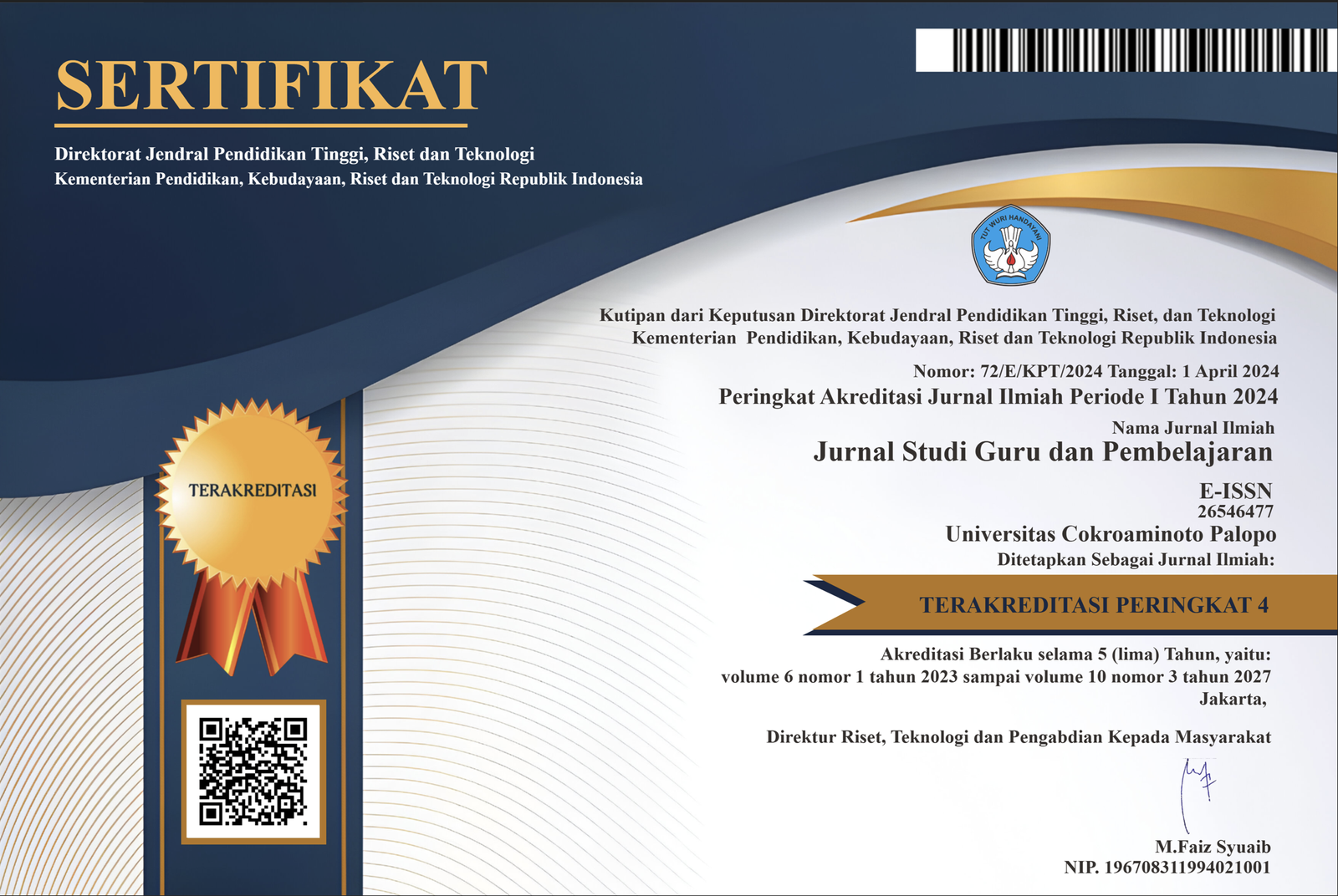The Impact of Repeated Reading Technique as A Phonological Practice Tool for Enhancing Pronunciation Clarity in EFL Learners at 11th Graders MA Birrul Walidain NW Rensing
DOI:
https://doi.org/10.30605/jsgp.8.3.2025.6825Keywords:
Pronunciation Clarity, Repeated Reading, Phonological Practice, EFL, quasi-experimental designAbstract
Pronunciation clarity is one of the most crucial aspects in mastering English for EFL learners, yet many students still struggle with phoneme articulation, word stress, and intonation. Preliminary observation at MA Birrul Walidain NW Rensing revealed that 11th-grade students frequently mispronounced phonemes such as /θ/ and /ð/, misplaced stress, and produced monotonous intonation, which hindered their intelligibility and confidence. This highlights the urgency of applying an effective and structured phonological training method to improve students’ pronunciation. The present study aimed to examine the impact of the Repeated Reading (RR) technique as a phonological practice tool to enhance pronunciation clarity. This research employed a quantitative approach with a quasi-experimental non-equivalent control group design. The study was conducted at MA Birrul Walidain NW Rensing during the 2025/2026 academic year, involving 26 eleventh-grade students selected randomly into experimental (n=12) and control groups (n=14). Data were collected through pre-test and post-test oral reading tasks, assessed with a pronunciation rubric covering both segmental and suprasegmental features. The instrument was validated by two English teachers, and data were analyzed using SPSS through Shapiro-Wilk test, Levene’s test, Paired Sample t-Test, and Independent Sample t-Test. The results showed that the experimental group’s mean score increased from 9.00 to 12.58 (SD=2.49 to 2.30), with a mean difference of 3.58 (t=10.62, p=0.000). In contrast, the control group only improved from 9.00 to 9.64 (mean difference=0.64, t=1.64, p=0.125). Independent Sample t-Test confirmed a significant difference in post-test scores between groups (mean diff=2.94, t=2.83, p=0.009). These findings indicate that RR significantly enhances pronunciation clarity, particularly in phoneme accuracy, stress placement, intonation, and rhythm. Thus, repeated reading can be considered an effective strategy for EFL pronunciation instruction.
Downloads
References
Alamri, M. A., & Qadha, A. M. (2025). The Impact of Pronunciation Clarity on the Accuracy and Speed of Simultaneous Interpretation: Challenges and Strategies. Egyptian Journal of Linguistics and Translation, 15(1), 382-413. https://doi.org/10.21608/ejlt.2025.390842.1111
Barnwal, S., & Tiwary, A. (2020). The effect of repeated reading technique on fluency and pronunciation in EFL learners. Journal of Language Education and Teaching, 8(2), 56–63. https://doi.org/10.30872/e3l.v7i2.5108
Chen, M., Xie, X., & Zhang, W. (2022). Phonological awareness training in EFL contexts: Effects on pronunciation and listening comprehension. Journal of Language Teaching and Research, 13(2), 275–283. http://dx.doi.org/10.1515/cjal-2015-0021
Creswell, J. W., & Creswell, J. D. (2023). Research design: Qualitative, quantitative, and mixed methods approaches (6th ed.). SAGE Publications.
Derwing, T. M., & Munro, M. J. (2021). Pronunciation fundamentals: Evidence-based perspectives for EFL teachers. Routledge. http://dx.doi.org/10.1075/lllt.42
Fatimah, I., & Suryani, E. (2021). The role of repeated reading technique in improving students' pronunciation and intonation. Journal of Language Education, 16(4), 142–155. https://doi.org/10.1016/j.jle.2021.04.009
Field, A. (2020). Discovering statistics using IBM SPSS Statistics (5th ed.). SAGE Publications.
Fraenkel, J. R., Wallen, N. E., & Hyun, H. H. (2020). How to design and evaluate research in education (10th ed.). McGraw-Hill Education.
Ghasemi, A., & Zahediasl, S. (2020). Normality tests for statistical analysis: A guide for non-statisticians. International Journal of Endocrinology and Metabolism, 18(1), e91720. https://doi.org/10.5812/ijem.3505
Gil, I. R., De Larios, J. R., & Coyle, Y. (2017). The effect of repeated reading on the pronunciation of young EFL learners. Porta Linguarum, 27, 7–19. http://dx.doi.org/10.30827/Digibug.53948
Gil, I. R., De Larios, J. R., & Coyle, Y. (2017). The effect of repeated reading on the pronunciation of young EFL learners. Porta Linguarum: revista internacional de didáctica de las lenguas extranjeras, (27), 7-19.
Harris, A. D., McGregor, J. C., Perencevich, E. N., Furuno, J. P., Zhu, J., Peterson, D. E., & Finkelstein, J. (2006). The use and interpretation of quasi-experimental studies in medical informatics. Journal of the American Medical Informatics Association, 13(1), 16-23. https://doi.org/10.1197/jamia.M1749
Huang, H. Y. C., Barrett, N. E., Lo, M. F., & Tseng, C. J. (2024). The effectiveness of shadowing practice with web-based apps: towards promoting the comprehensibility and lexical-level intelligibility of EFL students’ presentations. English Teaching & Learning, 48(4), 505-524. https://doi.org/10.1007/s42321-023-00145-w
Lee, J., & Kim, S. (2022). Repeated reading and its impact on pronunciation clarity and fluency in Korean EFL learners. TESOL Journal, 13(2), 33–41.
Namaziandost, E., Homayouni, M., & Rahmani, P. (2020). The impact of cooperative learning approach on the development of EFL learners’ speaking fluency. Cogent Arts & Humanities, 7(1), 1780811. https://doi.org/10.1080/23311983.2020.1780811
Nguyen, L. T., & Hung, B. P. (2021). Communicative pronunciation teaching: Insights from the Vietnamese tertiary EFL classroom. System, 101, 102573. https://doi.org/10.1016/j.system.2021.102573
Pallant, J. (2020). SPSS survival manual (7th ed.). McGraw-Hill Education.
Rasinski, T. (2020). The fluent reader: Oral reading strategies for building word recognition, fluency, and comprehension (2nd ed.). Scholastic.
Sugiyono. (2021). Metode penelitian kuantitatif, kualitatif, dan R&D. Alfabeta.
Sun, B., & Révész, A. (2021). The effects of task repetition on child EFL learners’ oral performance. Canadian Journal of Applied Linguistics, 24(2), 30-47. https://doi.org/10.37213/cjal.2021.31382
Takahashi, M. (2020). Using repeated reading to improve EFL students’ fluency and pronunciation: An exploratory study. Journal of Asia TEFL, 17(4), 1277–1284. https://doi.org/10.18823/asiatefl.2020.17.4.13.1277
Unsiyah, S. I. U., Amrizah, S., & Qolbi, A. N. (2024,). The Use of English Pronunciation Application as a Supporting Media in Enhancing Students’ Pronunciation. In Conference on English Language Teaching (pp. 223-236).
Uysal, P. K., & Duman, A. (2020). The effects of fluency-oriented reading instruction on reading skills. Pegem Journal of Education and Instruction, 10(4), 1111-1146. https://doi.org/10.14527/pegegog.2020.034
Zhang, X. (2024). Explicit Rules or Implicit Imitation: A Comparative Study of Two Approaches to Teaching English Prosody to Chinese Adult EFL Learners.
Downloads
Published
How to Cite
Issue
Section
License
Copyright (c) 2025 Iswari Maulinda, Ari Prasetyaningrum, Ahmad Yusri, Siti Maysuroh

This work is licensed under a Creative Commons Attribution-ShareAlike 4.0 International License.
In submitting the manuscript to the journal, the authors certify that:
- They are authorized by their co-authors to enter into these arrangements.
- The work described has not been formally published before, except in the form of an abstract or as part of a published lecture, review, thesis, or overlay journal.
- That it is not under consideration for publication elsewhere,
- That its publication has been approved by all the author(s) and by the responsible authorities – tacitly or explicitly – of the institutes where the work has been carried out.
- They secure the right to reproduce any material that has already been published or copyrighted elsewhere.
- They agree to the following license and copyright agreement.
License and Copyright Agreement
Authors who publish with JSGP agree to the following terms:
- Authors retain copyright and grant the journal right of first publication with the work simultaneously licensed under Creative Commons Attribution License (CC BY-SA 4.0) that allows others to share the work with an acknowledgement of the work's authorship and initial publication in this journal.
- Authors are able to enter into separate, additional contractual arrangements for the non-exclusive distribution of the journal's published version of the work (e.g., post it to an institutional repository or publish it in a book), with an acknowledgement of its initial publication in this journal.
- Authors are permitted and encouraged to post their work online (e.g., in institutional repositories or on their website) prior to and during the submission process, as it can lead to productive exchanges, as well as earlier and greater citation of published work.













